Toyota Corolla: If you have a flat tire (vehicles without spare tire) / Emergency repair method
1 Take out the repair kit from the plastic bag.
2 Remove the valve cap from the valve of the punctured tire.

3 Extend the hose. Remove the air release cap from the hose.
Attach the sticker enclosed with the bottle on the specified locations. (See step 10.)
You will use the air release cap again. Therefore keep it in a safe place.

4 Connect the hose to the valve.
Screw the end of the hose clockclockwise as far as possible.

5 Make sure that the compressor switch is off.
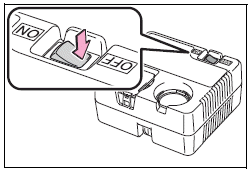
6 Lift the rubber stopper on the compressor.

7 Remove the power plug from the compressor.
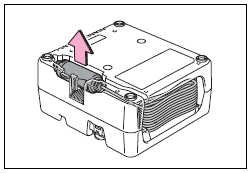
8 Connect the power plug to the power outlet socket.
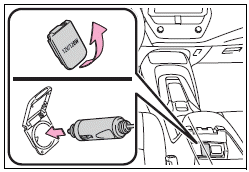
9 Connect the bottle to the compressor.
As shown in the illustration, insert the bottle securely into the compressor until the upper side of the mark on the bottle is aligned with the upper end of the notch.
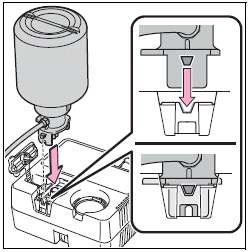
10 Attach the sticker provided with the tire puncture repair kit to a position easily seen from the driver’s seat.

A - U.S.A.
B - Canada
11 Check the specified tire inflation pressure.
Tire inflation pressure is specified on the label on the driver’s side pillar as shown.
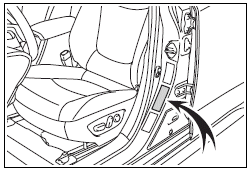
12 Start the engine.
13 To inject the sealant and inflate the tire, turn the compressor switch on.
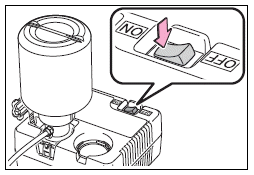
14 Inflate the tire until the specified air pressure is reached.

A - The sealant will be injected and the pressure will spike to between 44 psi (300 kPa, 3.0 kgf/cm2 or bar) and 58 psi (400 kPa, 4.0 kgf/cm2 or bar), then gradually decrease.
B - The air pressure gauge will display the actual tire inflation pressure about 1 to 5 minutes after the switch is turned on.
Turn the compressor switch off and then check the tire inflation pressure. Being careful not to over inflate, check and repeat the inflation procedure until the specified tire inflation pressure is reached.
The tire can be inflated for about 5 to 20 minutes (depending on the outside temperature). If the tire inflation pressure is still lower than the specified point after inflation for 25 minutes, the tire is too damaged to be repaired. Turn the compressor switch off and contact your Toyota dealer.
If the tire inflation pressure exceeds the specified air pressure, let out some air to adjust the tire inflation pressure.
15 With the compressor switch off, disconnect the hose from the valve on the tire and then pull out the power plug from the power outlet socket.
Some sealant may leak when the hose is removed.
16 Install the valve cap onto the valve of the emergency repaired tire.
17 Attach the air release cap to the end of the hose.
If the air release cap is not attached, the sealant may leak and the vehicle may get dirty.

18 Temporarily store the bottle in the trunk while it is connected to the compressor.
19 To spread the liquid sealant evenly within the tire, immediately drive safely for about 3 miles (5 km) below 50 mph (80 km/h).
20 After driving, stop your vehicle in a safe place on a hard, flat surface and reconnect the repair kit.
Remove the air release cap from the hose before reconnecting the hose.

21 Turn the compressor switch on and wait for several seconds, then turn it off. Check the tire inflation pressure.

A - If the tire inflation pressure is under 19 psi (130 kPa, 1.3 kgf/cm2 or bar): The puncture cannot be repaired. Contact your Toyota dealer.
B - If the tire inflation pressure is 19 psi (130 kPa, 1.3 kgf/cm2or bar) or higher, but less than the specified air pressure: Proceed to step 22.
С - If the tire inflation pressure is the specified air pressureю Proceed to step 23.
22 Turn the compressor switch on to inflate the tire until the specified air pressure is reached. Drive for about 3 miles (5 km) and then perform step 20.
23 Attach the air release cap to the end of the hose.
If the air release cap is not attached, the sealant may leak and the vehicle may get dirty.
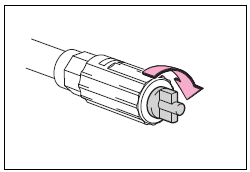
24 Store the bottle in the trunk while it is connected to the compressor.
25 Taking precautions to avoid sudden braking, sudden acceleration and sharp turns, drive carefully at under 50 mph (80 km/h) to the nearest Toyota dealer that is less than 62 miles (100 km) away for tire repair or replacement.
When having the tire repaired or replaced, make sure to tell the Toyota dealer that the sealant is injected.
■ If the tire is inflated to more than the specified air pressure
1 Disconnect the hose from the valve.
2 Install the air release cap to the end of the hose and push the protrusion on the air release cap into the tire valve to let some air out.

3 Disconnect the hose from the valve, remove the air release cap from the hose and then reconnect the hose.
4 Turn the compressor switch on and wait for several seconds, and then turn it off. Check that the air pressure indicator shows the specified air pressure.
If the air pressure is under the designated pressure, turn the compressor switch on again and repeat the inflation procedure until the specified air pressure is reached.
■ The valve of a tire that has been repaired (vehicles without a tire pressure warning system)
After a tire is repaired with the emergency tire puncture repair kit, the valve should be replaced.
■ After a tire is repaired with the emergency tire puncture repair kit (vehicles with a tire pressure warning system)
- The tire pressure warning valve and transmitter should be replaced.
- Even if the tire inflation pressure is at the recommended level, the tire pressure warning light may come on/flash.
WARNING
■ Do not drive the vehicle with a flat tire
Do not continue driving with a flat tire.
Driving even a short distance with a flat tire can damage the tire and the wheel beyond repair.
Driving with a flat tire may cause a circumferential groove on the side wall. In such a case, the tire may explode when using a repair kit.
■ When fixing the flat tire
- Stop your vehicle in a safe and flat area.
- Do not touch the wheels or the area around the brakes immediately after the vehicle has been driven. After the vehicle has been driven, the wheels and the area around the brakes may be extremely hot. Touching these areas with hands, feet or other body parts may result in burns.
- Connect the valve and hose securely with the tire installed on the vehicle. If the hose is not properly connected to the valve, air leakage may occur as sealant may be sprayed out.
- If the hose comes off the valve while inflating the tire, there is a risk that the hose will move abruptly due to air pressure.
- After inflation of the tire has completed, the sealant may splatter when the hose is disconnected or some air is let out of the tire.
- Follow the operation procedure to repair the tire. If the procedures not followed, the sealant may spray out.
- Keep back from the tire while it is being repaired, as there is a chance of it bursting while the repair operation is being performed. If you notice any cracks or deformation of the tire, turn off the compressor switch and stop the repair operation immediately.
- The repair kit may overheat if operated for a long period of time. Do not operate the repair kit continuously for more than 40 minutes.
- Parts of the repair kit become hot during operation. Be careful handling the repair kit during and after operation. Do not touch the metal part connecting the bottle and the compressor. It will be extremely hot.
- Do not attach the vehicle speed warning sticker to an area other than the one indicated. If the sticker is attached to an area where an SRS airbag is located, such as the pad of the steering wheel, it may prevent the SRS airbag from operating properly.
■ Driving to spread the liquid sealant evenly
Observe the following precautions to reduce the risk of accidents. Failing to do so may result in a loss of vehicle control and cause death or serious injury.
- Drive the vehicle carefully at a low speed. Be especially careful when turning and cornering.
- If the vehicle does not drive straight or you feel a pull through the
steering wheel, stop the vehicle and check the following.
- Tire condition. The tire may have separated from the wheel.
- Tire inflation pressure. If the tire inflation pressure is 19 psi (130 kPa, 1.3 kgf/cm2 or bar) or less, the tire may be severely damaged.
NOTICE
■ When performing an emergency repair
- A tire should only be repaired with the emergency tire puncture repair kit if the damage is caused by a sharp object such as nail or screw passing through the tire tread. Do not remove the sharp object from the tire. Removing the object may widen the opening and disenable emergency repair with the repair kit.
- The repair kit is not waterproof. Make sure that the repair kit is not exposed to water, such as when it is being used in the rain.
- Do not put the repair kit directly onto dusty ground such as sand at the side of the road. If the repair kit vacuums up dust etc., a malfunction may occur.
■ Precautions for the emergency tire puncture repair kit
- The repair kit power source should be 12 V DC suitable for vehicle use. Do not connect the repair kit to any other source.
- If fuel splatters on the repair kit, the repair kit may deteriorate. Take care not to allow fuel to contact it.
- Place the repair kit in a storage to prevent it from being exposed to dirt or water.
- Store the repair kit in the trunk out of reach of children.
- Do not disassemble or modify the repair kit. Do not subject parts such as the air pressure indicator to impacts. This may cause a malfunction.
■ To avoid damage to the tire pressure warning valves and transmitters (vehicles with a tire pressure warning system)
When a tire is repaired with liquid sealants, the tire pressure warning valve and transmitter may not operate properly. If a liquid sealant is used, contact your Toyota dealer or other qualified service shop as soon as possible. After use of liquid sealant, make sure to replace the tire pressure warning valve and transmitter when repairing or replacing the tire.
 Emergency tire puncture repair kit components
Emergency tire puncture repair kit components
► Bottle
A - Hose
B - Air release cap
C - Sticker
► Compressor
A - Power plug
B - Rubber stopper
C - Air pressure gauge
D - Compressor switch
■ Note for checking the emergency tire puncture repair kit
Check the sealant expiry date occasionally...
 If you have a flat tire (vehicles with a spare tire)
If you have a flat tire (vehicles with a spare tire)
Your vehicle is equipped with a spare tire. The flat tire can be replaced with
the spare tire.
WARNING
■ If you have a flat tire
Do not continue driving with a flat tire...
Other information:
Toyota Corolla 2019-2026 Owners Manual: Gauges and meters (7-inch display)
Meter display ■ Locations of gauges and meters ► Analog speedometer The units of measure may differ depending on the intended destination of the vehicle. A - Tachometer<> Displays the engine speed in revolutions per minute B - Speedometer C - Sub speedometer D - Clock (®P...
Toyota Corolla 2019-2026 Owners Manual: Wireless charger
A portable device, such as a smartphone or mobile battery, can be charged by just placing it on the charging area, provided the device is compatible with the Qi wireless charging standard created by the Wireless Power Consortium. The wireless charger cannot be used with a portable device that is larger than the charging area...
Categories
- Manuals Home
- 12th Generation Corolla Owners Manual
- Operating HomeLink
- iMT (Intelligent Manual Transmission)
- Sensors
- New on site
- Most important about car
Unlocking and locking the doors from the outside
■ Smart key system (if equipped)
Carry the electronic key to enable this function.

1 Grip the driver’s door handle to unlock the door. Holding the driver’s door handle for approximately 2 seconds unlocks all the doors. Grip the front passenger’s door handle to unlock all the doors.*
